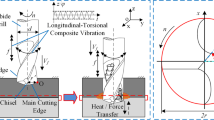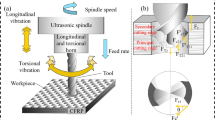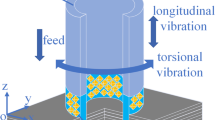Abstract
Longitudinal torsional coupled rotary ultrasonic–assisted drilling (LTC-RUAD) technology is introduced to improve the surface roughness of the hole-wall and solve the tear, burr, and delamination of carbon fiber–reinforced polymers (CFRPs) induced by large thrust force and torque during conventional drilling (CD). An experiment and scale-span numerical investigation of drilling CFRPs were presented for both the CD and LTC-RUAD processes in this study. A drilling experimental platform using the LTC-RUAD was built via a novel independently designed and manufactured LTC-RUAD vibration actuator, while the drilling experiments involving T700S-12 K/YP-H26 CFRP specimens with different process parameters were carried out by adopting the different ultrasonic vibration amplitude (UVA) in the longitudinal and torsional directions. Then, a three-dimensional (3D) scale-span FE simulation model of the CD and LTC-RUAD which applied the different UVA using tapered drill-reamer (TDR) is developed to find more details about the effects of machining quality of the holes. Experimental and simulation results revealed that the maximum average thrust force reduction is observed to be as high as 30% under certain drilling conditions, and the maximum average thrust force and the delamination factor of the drilled hole shows a “concave” trend with the increase of the UVA. The quality at the exit of the drilled hole is best when adopting Sr = 2000 rpm, Sf = 0.01 mm/rev, Alon = 7.02 μm, and Ator = 9.29 μm in the LTC-RUAD. The delamination factor is only 0.054, and the damage factors are reduced by 69.67% compared with CD.


















Similar content being viewed by others
Availability of data and materials
The experimental and simulation data is transparent.
References
Qi Z, Ge E, Yang J, Li F, Jin S (2021) Influence mechanism of multi-factor on the diameter of the stepped hole in the drilling of CFRP/Ti stacks. Int J Adv Manuf Technol 113:923–933
Liu Y, Qi Z, Chen W, Wang X (2019) An approach to design high-performance unidirectional CFRPs based on a new sensitivity analysis model Compos Struct 224:111078.
Abhishek K, Datta S, Mahapatra SS (2014) Optimization of thrust, torque, entry, and exist delamination factor during drilling of CFRP composites. Int J Adv Manuf Technol 76(1–4):401–416
Geng D, Liu Y, Shao Z, Lu Z, Cai J, Li X, Jiang X, Zhang D (2019) Delamination formation, evaluation and suppression during drilling of composite laminates: a review. Compos Struct 216:168–186
Geng D, Teng Y, Liu Y, Shao Z, Jiang X, Zhang D (2019) Experimental study on drilling load and hole quality during rotary ultrasonic helical machining of small-diameter CFRP holes. J Mater Process Technol 270:195–205
Chen Y, Su H, Qian N, He J, Ding K (2021) Ultrasonic vibration-assisted grinding of silicon carbide ceramics based on actual amplitude measurement: grinding force and surface quality. Ceram Int 47:15433–15441
Zhang D, Wang H, Burks AR, Cong W (2020) Delamination in rotary ultrasonic machining of CFRP composites: finite element analysis and experimental implementation. Int J Adv Manuf Technol 107(1):1–12
Liu Y, Li Q, Qi Z, Chen W (2021a) Defect suppression mechanism and experimental study on longitudinal torsional coupled rotary ultrasonic assisted drilling of CFRPs. J Manuf Process 70:177–192. https://doi.org/10.1016/j.jmapro.2021.08.042
Wang J, Zhang J, Feng P, Ping Q (2018) Feasibility study of longitudinal torsional coupled rotary ultrasonic machining of brittle material. J. Eng. Ind. 140(5): 051008.
Wang J, Feng P, Zhang J, Guo P (2018) Reducing cutting force in rotary ultrasonic drilling of ceramic matrix composites with longitudinal-torsional coupled vibration. Manuf. Lett. 18:1–5
Sadek A, Attia MH, Meshreki M, Shi B (2013) Characterization and optimization of vibration-assisted drilling of fibre reinforced epoxy laminates. CIRP Ann Manuf Technol 62(1):91–94
Cong WL, Pei ZJ, Sun X, Zhang C (2014) Rotary ultrasonic machining of CFRP: a mechanistic predictive model for cutting force. Ultrasonics 54(2):663–675
Wang H, Ning F, Li Y, Hu Y, Cong W (2019) Scratching-induced surface characteristics and material removal mechanisms in rotary ultrasonic surface machining of CFRP. Ultrasonics 97:19–28
Wang H, Hu Y, Cong W, Burks A (2019) Rotary ultrasonic machining of carbon fiber–reinforced plastic composites: effects of ultrasonic frequency. Int J Adv Manuf Technol 104(3):3759–3772
Thomas PNH, Babitsky VI (2017) Experiments and simulations on ultrasonically assisted drilling. J Sound Vib 308(3–5):815–830
Makhdum F, Phadnis VA, Roy A, Silberschmidt V (2014) Effect of ultrasonically-assisted drilling on carbon-fibre-reinforced plastics. J Sound Vib 333(23):5939–5952
Asami T, Miura H (2015) Study of ultrasonic machining using longitudinal and torsional vibration, 2015 IEEE International Ultrasonics Symposium (IUS). IEEE.
Lotfi M, Amini S (2016) Effect of ultrasonic vibration on frictional behavior of tool–chip interface: finite element analysis and experimental study. Proc. Inst. Mech. Eng., Part B 7:1212–1220
Phadnis VA, Makhdum F, Roy A, Silberschmidt V (2012) Experimental and numerical investigations in conventional and ultrasonically assisted drilling of CFRP laminate. Procedia Cirp 1(7):455–459
Phadnis VA, Roy A, Silberschmidt VV (2013) A finite element model of ultrasonically assisted drilling in carbon/epoxy composites. Procedia CIRP 8(1):141–146
Gomes GF, Diniz CA, Da Cunha SS, Ancelotti AC (2017) Design optimization of composite prosthetic tubes using GA-ANN algorithm considering Tsai-Wu failure criteria. J Fail Anal Prev 17:740–749
Hashin Z, Rotem A (1973) A fatigue failure criterion for fiber reinforced materials. J Compos Mater 7(4):448–464
Hashin Z (1981) Fatigue failure criteria for unidirectional fiber composites. J Appl Mech 48(4):846
Puck AH (2002) Schürmann. Failure analysis of FRP laminates by means of physically based phenomenological models. Compos Sci Technol 62:1633–1662
Chang FK, Chang KY (1987) A progressive damage model for laminated composites containing stress concentrations. J Compos Mater 21(9):834–855
Ma X, Li Y, Gu Y, Li M, Zhang Z (2014) Numerical simulation of prepreg resin impregnation effect in vacuum-assisted resin infusion/prepreg co-curing process. J Reinf Plast Compos 33:2265–2273
Tsao CC, Hocheng H (2008) Evaluation of thrust force and surface roughness in drilling composite material using Taguchi analysis and neural network. J Mater Process Technol 203(1–3):342–348
Wang F, Qian B, Jia Z, Cheng D, Fu R (2018) Effects of cooling position on tool wear reduction of secondary cutting edge corner of one-shot drill bit in drilling CFRP. Int J Adv Manuf Technol 94:4277–4287
Liu Y, Li Q, Qi Z, Chen W (2021b) Scale-span modelling of dynamic progressive failure in drilling CFRPs using a tapered drill-reamer. Compos Struct 278:114710. https://doi.org/10.1016/j.compstruct.2021.114710
Qi Z, Liu Y, Chen W (2019) An approach to predict the mechanical properties of CFRP based on cross-scale simulation. Compos Struct 210:339–347
Ducobu F, Rivière-Lorphèvre E, Filippi E (2015) On the introduction of adaptive mass scaling in a finite element model of Ti6Al4V orthogonal cutting. Simul Model Pract Theory 53:1–14
Chen L, Zhang K, Hui C, Qi Z, Meng Q (2017) A cutting force predicting model in orthogonal machining of unidirectional CFRP for entire range of fiber orientation. Int J Adv Manuf Technol 89(1–4):1–14
Faraz A, Biermann D, Weinert K (2009) Cutting edge rounding: an innovative tool wear criterion in drilling CFRP composite laminates. Int J Mach Tools Manuf 49(15):1185–1196
Acknowledgements
The authors would like to acknowledge the editors and the anonymous referees for their insightful comments.
Funding
Authors declare that we have no financial and personal relationships with other people or organizations that can inappropriately influence our work. The work reported herein is sponsored by the National Natural Science Foundation of China (52105450, 51605221, 51875283), the University Science Research Project of Jiangsu Province (No. 21KJB460016), the Aeronautical Science Foundation of China (2017ZE52052), and the National Commercial Aircraft Manufacturing Engineering Technology Research Center Innovation Foundation (COMAC-SFGS-2019-341).
Author information
Authors and Affiliations
Contributions
Yong Liu designed the study, performed the research, analyzed the data, and wrote the paper. Zitao Pan and Qiannan Li conducted experiments and data processing. Zhenchao Qi provided experimental condition and directed experiments. Wenliang Chen modified the paper.
Corresponding authors
Ethics declarations
Ethics approval
This article does not contain any studies with human participants performed by any of the authors.
Consent to participate
This work was conducted with no human test subjects.
Consent for publication
This work has consent for publication.
Competing interests
The authors declare no competing interests.
Additional information
Publisher's Note
Springer Nature remains neutral with regard to jurisdictional claims in published maps and institutional affiliations.
Rights and permissions
About this article
Cite this article
Liu, Y., Pan, Z., Li, Q. et al. Experimental and scale-span numerical investigations in conventional and longitudinal torsional coupled rotary ultrasonic–assisted drilling of CFRPs. Int J Adv Manuf Technol 119, 1707–1724 (2022). https://doi.org/10.1007/s00170-021-08286-7
Received:
Accepted:
Published:
Issue Date:
DOI: https://doi.org/10.1007/s00170-021-08286-7




